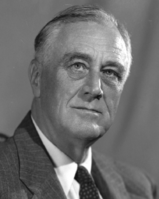| ||||||||||||||||||||||||||
All 7 Nebraska votes to the Electoral College | ||||||||||||||||||||||||||
|---|---|---|---|---|---|---|---|---|---|---|---|---|---|---|---|---|---|---|---|---|---|---|---|---|---|---|
| ||||||||||||||||||||||||||
 County Results
| ||||||||||||||||||||||||||
| ||||||||||||||||||||||||||
| Elections in Nebraska |
|---|
 |
|
|
The 1940 United States presidential election in Nebraska took place on November 5, 1940, as part of the 1940 United States presidential election. Voters chose seven[2] representatives, or electors, to the Electoral College, who voted for president and vice president.
Nebraska was won by the Republican candidate, business man Wendell Willkie, running with Senate Minority Leader Charles L. McNary, with 57.19% of the popular vote, against incumbent Democratic President Franklin D. Roosevelt, running with Secretary Henry A. Wallace, with 42.81% of the popular vote.[3][4]
Though he had carried the state by over 16 points just four years earlier in 1936, Roosevelt's popularity with Nebraskans completely eroded in 1940, and with 57.19% of the popular vote, the state would prove to be Willkie's second strongest state in the 1940 election, after neighboring South Dakota. Roosevelt lost the state by almost exactly the same margin as he had carried it four years prior.[5] This constituted a Republican victory margin of 14.4%, with the results in Nebraska representing a very large 30.8% shift to the right from 1936. Nebraska weighed in as a drastic 24.3% more Republican than the nation as whole. Roosevelt became the first Democrat since Grover Cleveland in 1892 to win the presidency without carrying Nebraska.
Key to Willkie's landslide victory was his overperformance among rural farmers in Nebraska, whom Roosevelt had carried decisively in 1936. Willkie flipped 39 counties that had been reliably Democratic just 4 years earlier, those being: Banner, Blaine, Box Butte, Boyd, Burt, Chase, Cherry, Cheyenne, Cuming, Custer, Dawes, Dawson, Deuel, Dodge, Dundy, Frontier, Gosper, Grant, Harlan, Hayes, Hitchcock, Holt, Keith, Kimball, Knox, Madison, Merrick, Morrill, Pawnee, Perkins, Phelps, Pierce, Red Willow, Scotts Bluff, Sheridan, Sioux, Stanton, Thomas and Wayne.
The 1940 election would mark a turning point in Nebraska's politics; the state has voted for the Republican nominee by double digits in every election since, except for when Lyndon B. Johnson carried it by a fairly narrow margin of 5.2% amidst a national landslide victory. FDR's implosion among farmers can likely be attributed to his New Deal programs that paid farmers not to produce food and to destroy some crops, which was an attempt to cure the problem of food overproduction; the policy instead resulted in the United States needing to import food from other countries and paying more for it.[6][7] Additionally, as Roosevelt was running for his third consecutive term, many voters were warying of breaking the long-standing two term tradition.
- ^ "United States Presidential election of 1940 - Encyclopædia Britannica". Retrieved August 19, 2018.
- ^ "1940 Election for the Thirty-ninth Term (1941-45)". Retrieved August 19, 2018.
- ^ "1940 Presidential General Election Results - Nebraska". Retrieved August 19, 2018.
- ^ "The American Presidency Project - Election of 1940". Retrieved August 19, 2018.
- ^ "1940 Presidential Election Statistics". Dave Leip’s Atlas of U.S. Presidential Elections. Retrieved March 5, 2018.
- ^ "F.D.R.'s Disastrous Experiment". www.nytimes.com. Retrieved May 7, 2023.
- ^ "Farmers and the New Deal". History Learning Site. Retrieved May 7, 2023.
© MMXXIII Rich X Search. We shall prevail. All rights reserved. Rich X Search


